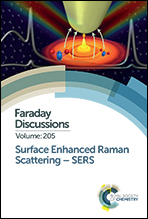Novel routes to electromagnetic enhancement and its characterisation in surface- and tip-enhanced Raman scattering
Abstract
Quantitative understanding of the electromagnetic component in enhanced Raman spectroscopy is often difficult to achieve on account of the complex substrate structures utilised. We therefore turn to two structurally simple systems amenable to detailed modelling. The first is tip-enhanced Raman scattering under electron scanning tunnelling microscopy control (STM-TERS) where, appealing to understanding developed in the context of photon emission from STM, it is argued that the localised surface plasmon modes driving the Raman enhancement exist in the visible and near-infrared regime only by virtue of significant modification to the optical properties of the tip and sample metals (gold here). This is due to the strong dc field-induced (∼109 V m−1) non-linear corrections to the dielectric function of gold via the third order susceptibility term in the polarisation. Also, sub-5 nm spatial resolution is shown in the modelling. Secondly, we suggest a novel deployment of hybrid plasmonic waveguide modes in surface enhanced Raman scattering (HPWG-SERS). This delivers strong confinement of electromagnetic energy in a ∼10 nm oxide ‘gap’ between a high-index dielectric material of nanoscale width (a GaAs nanorod and a 100 nm Si slab are considered here) and a metal, yielding a monotonic variation in the Raman enhancement factor as a function of wavelength with no long-wavelength cut-off, both features that contrast with STM-TERS.
- This article is part of the themed collection: Surface Enhanced Raman Scattering - SERS


 Please wait while we load your content...
Please wait while we load your content...